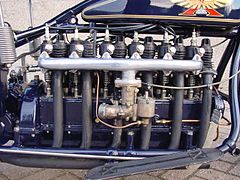

This article needs additional citations for verification. Please help improve this articlebyadding citations to reliable sources. Unsourced material may be challenged and removed.
Find sources: "Longitudinal engine" – news · newspapers · books · scholar · JSTOR (May 2021) (Learn how and when to remove this message) |


Inautomotive engineering, a longitudinal engine is an internal combustion engine in which the crankshaft is oriented along the long axis of the vehicle, from front to back.[1][2]
This type of motor is usually used for rear-wheel drive cars, except for some Audi, SAAB, the Oldsmobile Toronado, and the 1967 Cadillac Eldorado equipped with longitudinal engines in front wheel drive. In front-wheel drive cars a transverse engine is usually used. Trucks often have longitudinal engines with rear-wheel drive.
For motorcycles, the use of a particular type depends on the drive: in the case of a chain or belt drive a transverse engine is usually used, and with shaft drives a longitudinal engine. Longitudinal engines in motorcycles do have one disadvantage: the "tipping point" of the crankshaft tilts along the entire motorcycle to a greater or lesser degree when accelerating. This is partly resolved by having other components, such as the generator and the gearbox, rotate in the opposite direction to the crankshaft.
Most larger, "premium" vehicles use the longitudinal engine orientation in combination with rear wheel drive, because powerful engines such as the inline-6 and 90° big-bore V8 are usually too long to fit in a FF transverse engine bay. By contrast most mainstream modern vehicles use front wheel drive along with a transverse engine arrangement since they are usually equipped with inline-4 or V6 engines. While both layouts can be adapted for all-wheel drive, the longitudinal engine orientation has a more balanced weight distribution leading to superior handling characteristics, but is less efficient in terms of packaging and interior space.[3]
Cars with longitudinal engines usually have a smaller minimum turning circle than those with transverse engines. This is because there is more space to the sides of the engine, allowing deeper wheel arches so the front wheels are able to turn through a greater angle.
In the late 1960s, GM divisions Oldsmobile and Cadillac had front-wheel drive models Toronado and Eldorado respectively, with a longitudinal V8 engine and an integrated automatic transmission and differential unit powering the front wheels. Honda and Toyota also offered front-wheel drive cars with longitudinal engines, namely Honda Vigor, Acura/Honda Legend/RL, and Toyota Tercel.
This is a list of typical examples of types of engines which can be placed in motor vehicles:
Longitudinal engine mounting An engine mounted lengthways in the chassis.
A longitudinal engine mounts the crankshaft centerline front to rear when viewed from the top.